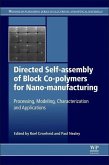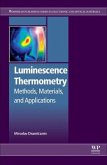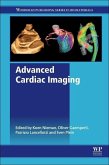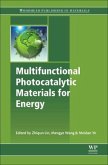Modeling, Characterization and Production of Nanomaterials
Electronics, Photonics and Energy Applications
Herausgeber: Tewary, V.; Zhang, Y.
Modeling, Characterization and Production of Nanomaterials
Electronics, Photonics and Energy Applications
Herausgeber: Tewary, V.; Zhang, Y.
- Gebundenes Buch
- Merkliste
- Auf die Merkliste
- Bewerten Bewerten
- Teilen
- Produkt teilen
- Produkterinnerung
- Produkterinnerung
Nano-scale materials have unique electronic, optical, and chemical properties which make them attractive for a new generation of devices. Part one of Modeling, Characterization, and Production of Nanomaterials: Electronics, Photonics and Energy Applications covers modeling techniques incorporating quantum mechanical effects to simulate nanomaterials and devices, such as multiscale modeling and density functional theory. Part two describes the characterization of nanomaterials using diffraction techniques and Raman spectroscopy. Part three looks at the structure and properties of nanomaterials,…mehr
Andere Kunden interessierten sich auch für
![Directed Self-Assembly of Block Co-Polymers for Nano-Manufacturing Directed Self-Assembly of Block Co-Polymers for Nano-Manufacturing]() Directed Self-Assembly of Block Co-Polymers for Nano-Manufacturing125,99 €
Directed Self-Assembly of Block Co-Polymers for Nano-Manufacturing125,99 €![Wide Bandgap Power Semiconductor Packaging Wide Bandgap Power Semiconductor Packaging]() Wide Bandgap Power Semiconductor Packaging144,99 €
Wide Bandgap Power Semiconductor Packaging144,99 €![Luminescence Thermometry Luminescence Thermometry]() Miroslav DramicaninLuminescence Thermometry133,99 €
Miroslav DramicaninLuminescence Thermometry133,99 €![Developments in Surface Contamination and Cleaning: Methods for Surface Cleaning Developments in Surface Contamination and Cleaning: Methods for Surface Cleaning]() Rajiv KohliDevelopments in Surface Contamination and Cleaning: Methods for Surface Cleaning159,99 €
Rajiv KohliDevelopments in Surface Contamination and Cleaning: Methods for Surface Cleaning159,99 €![Advanced Cardiac Imaging Advanced Cardiac Imaging]() Advanced Cardiac Imaging172,99 €
Advanced Cardiac Imaging172,99 €![Multifunctional Photocatalytic Materials for Energy Multifunctional Photocatalytic Materials for Energy]() YeMultifunctional Photocatalytic Materials for Energy140,99 €
YeMultifunctional Photocatalytic Materials for Energy140,99 €![Synthesis of Inorganic Nanomaterials Synthesis of Inorganic Nanomaterials]() Synthesis of Inorganic Nanomaterials137,99 €
Synthesis of Inorganic Nanomaterials137,99 €-
-
-
Nano-scale materials have unique electronic, optical, and chemical properties which make them attractive for a new generation of devices. Part one of Modeling, Characterization, and Production of Nanomaterials: Electronics, Photonics and Energy Applications covers modeling techniques incorporating quantum mechanical effects to simulate nanomaterials and devices, such as multiscale modeling and density functional theory. Part two describes the characterization of nanomaterials using diffraction techniques and Raman spectroscopy. Part three looks at the structure and properties of nanomaterials, including their optical properties and atomic behaviour. Part four explores nanofabrication and nanodevices, including the growth of graphene, GaN-based nanorod heterostructures and colloidal quantum dots for applications in nanophotonics and metallic nanoparticles for catalysis applications.
Produktdetails
- Produktdetails
- Woodhead Publishing Series in Electronic and Optical Materials
- Verlag: Elsevier Science & Technology / Woodhead Publishing
- Artikelnr. des Verlages: C2013-0-16490-2
- Seitenzahl: 554
- Erscheinungstermin: 18. März 2015
- Englisch
- Abmessung: 236mm x 156mm x 30mm
- Gewicht: 950g
- ISBN-13: 9781782422280
- ISBN-10: 1782422285
- Artikelnr.: 42018904
- Herstellerkennzeichnung
- Libri GmbH
- Europaallee 1
- 36244 Bad Hersfeld
- gpsr@libri.de
- Woodhead Publishing Series in Electronic and Optical Materials
- Verlag: Elsevier Science & Technology / Woodhead Publishing
- Artikelnr. des Verlages: C2013-0-16490-2
- Seitenzahl: 554
- Erscheinungstermin: 18. März 2015
- Englisch
- Abmessung: 236mm x 156mm x 30mm
- Gewicht: 950g
- ISBN-13: 9781782422280
- ISBN-10: 1782422285
- Artikelnr.: 42018904
- Herstellerkennzeichnung
- Libri GmbH
- Europaallee 1
- 36244 Bad Hersfeld
- gpsr@libri.de
- List of contributors
- Woodhead Publishing Series in Electronic and Optical Materials
- Part One: Modeling techniques for nanomaterials
- 1: Multiscale modeling of nanomaterials: recent developments and future prospects
- Abstract
- 1.1 Introduction
- 1.2 Methods
- 1.3 Nanomaterials
- 1.4 Application examples
- 1.5 Conclusion
- 2: Multiscale Green's functions for modeling of nanomaterials
- Abstract
- Acknowledgments
- 2.1 Introduction
- 2.2 Green's function method: the basics
- 2.3 Discrete lattice model of a solid
- 2.4 Lattice statics Green's function
- 2.5 Multiscale Green's function
- 2.6 Causal Green's function for temporal modeling
- 2.7 Application to 2D graphene
- 2.8 Conclusions and future work
- 3: Numerical simulation of nanoscale systems and materials
- Abstract
- Acknowledgments
- 3.1 Introduction
- 3.2 Molecular statics and dynamics: an overview
- 3.3 Static calculations of strain due to interface
- 3.4 Dynamic calculations of kinetic frictional properties
- 3.5 Fundamental properties of dynamic ripples in graphene
- 3.6 Conclusions and general remarks
- Disclaimer
- 1: Multiscale modeling of nanomaterials: recent developments and future prospects
- Part Two: Characterization techniques for nanomaterials
- 4: TEM studies of nanostructures
- Abstract
- Acknowledgments
- 4.1 Introduction
- 4.2 Polarity determination and stacking faults of 1D ZnO nanostructures
- 4.3 Structure analysis of superlattice nanowire by TEM: a case of SnO2 (ZnO:Sn)n nanowire
- 4.4 TEM analysis of 1D nanoheterostructure
- 4.5 Concluding remarks
- 5: Characterization of strains and defects in nanomaterials by diffraction techniques
- Abstract
- Acknowledgments
- 5.1 Introduction
- 5.2 Section 1: diffraction profile shift due to residual strains/stresses
- 5.3 Section 1: conclusions
- 5.4 Section 2: diffraction profile broadening due to crystalline defects and strains and their influence on ferroelectric thin films
- 5.5 Section 2: conclusions
- 6: Recent advances in thermal analysis of nanoparticles: methods, models and kinetics
- Abstract
- 6.1 Introduction
- 6.2 Thermal analysis methods
- 6.3 Thermal analysis of nanoparticle purity and composition
- 6.4 Evaluation of nanoparticle-containing composites
- 6.5 Monitoring kinetics of thermal transitions
- 6.6 Trends in development of thermal analysis for nanoparticles
- 6.7 Conclusions
- 7: Raman spectroscopy and molecular simulation studies of graphitic nanomaterials
- Abstract
- 7.1 Introduction
- 7.2 Literature review
- 7.3 Methodology
- 7.4 Temperature-dependent Raman spectra
- 7.5 Application of MD to SWCNT structural analysis
- 7.6 Conclusion
- 4: TEM studies of nanostructures
- Part Three: Structure and properties of nanomaterials: modeling and its experimental applications
- 8: Carbon-based nanomaterials
- Abstract
- 8.1 Introduction
- 8.2 Outline
- 8.3 Electronic structure of graphite
- 8.4 Types of CNTs
- 8.5 Types of nanoribbons
- 8.6 DOS and quantum capacitance
- 8.7 CNT tunnel FETs
- 8.8 ITRS requirements-2024
- 8.9 Comparison between a CNT-MOSFET and TFET
- 8.10 Carbon nanotube vs. graphene nanoribbon
- 8.11 Summary
- 9: Atomic behavior and structural evolution of alloy nanoparticles during thermodynamic processes
- Abstract
- 9.1 Introduction
- 9.2 Simulation method
- 9.3 Results and discussion
- 9.4 Conclusions and future outlook
- 8: Carbon-based nanomaterials
- Part Four: Nanofabrication and n
- List of contributors
- Woodhead Publishing Series in Electronic and Optical Materials
- Part One: Modeling techniques for nanomaterials
- 1: Multiscale modeling of nanomaterials: recent developments and future prospects
- Abstract
- 1.1 Introduction
- 1.2 Methods
- 1.3 Nanomaterials
- 1.4 Application examples
- 1.5 Conclusion
- 2: Multiscale Green's functions for modeling of nanomaterials
- Abstract
- Acknowledgments
- 2.1 Introduction
- 2.2 Green's function method: the basics
- 2.3 Discrete lattice model of a solid
- 2.4 Lattice statics Green's function
- 2.5 Multiscale Green's function
- 2.6 Causal Green's function for temporal modeling
- 2.7 Application to 2D graphene
- 2.8 Conclusions and future work
- 3: Numerical simulation of nanoscale systems and materials
- Abstract
- Acknowledgments
- 3.1 Introduction
- 3.2 Molecular statics and dynamics: an overview
- 3.3 Static calculations of strain due to interface
- 3.4 Dynamic calculations of kinetic frictional properties
- 3.5 Fundamental properties of dynamic ripples in graphene
- 3.6 Conclusions and general remarks
- Disclaimer
- 1: Multiscale modeling of nanomaterials: recent developments and future prospects
- Part Two: Characterization techniques for nanomaterials
- 4: TEM studies of nanostructures
- Abstract
- Acknowledgments
- 4.1 Introduction
- 4.2 Polarity determination and stacking faults of 1D ZnO nanostructures
- 4.3 Structure analysis of superlattice nanowire by TEM: a case of SnO2 (ZnO:Sn)n nanowire
- 4.4 TEM analysis of 1D nanoheterostructure
- 4.5 Concluding remarks
- 5: Characterization of strains and defects in nanomaterials by diffraction techniques
- Abstract
- Acknowledgments
- 5.1 Introduction
- 5.2 Section 1: diffraction profile shift due to residual strains/stresses
- 5.3 Section 1: conclusions
- 5.4 Section 2: diffraction profile broadening due to crystalline defects and strains and their influence on ferroelectric thin films
- 5.5 Section 2: conclusions
- 6: Recent advances in thermal analysis of nanoparticles: methods, models and kinetics
- Abstract
- 6.1 Introduction
- 6.2 Thermal analysis methods
- 6.3 Thermal analysis of nanoparticle purity and composition
- 6.4 Evaluation of nanoparticle-containing composites
- 6.5 Monitoring kinetics of thermal transitions
- 6.6 Trends in development of thermal analysis for nanoparticles
- 6.7 Conclusions
- 7: Raman spectroscopy and molecular simulation studies of graphitic nanomaterials
- Abstract
- 7.1 Introduction
- 7.2 Literature review
- 7.3 Methodology
- 7.4 Temperature-dependent Raman spectra
- 7.5 Application of MD to SWCNT structural analysis
- 7.6 Conclusion
- 4: TEM studies of nanostructures
- Part Three: Structure and properties of nanomaterials: modeling and its experimental applications
- 8: Carbon-based nanomaterials
- Abstract
- 8.1 Introduction
- 8.2 Outline
- 8.3 Electronic structure of graphite
- 8.4 Types of CNTs
- 8.5 Types of nanoribbons
- 8.6 DOS and quantum capacitance
- 8.7 CNT tunnel FETs
- 8.8 ITRS requirements-2024
- 8.9 Comparison between a CNT-MOSFET and TFET
- 8.10 Carbon nanotube vs. graphene nanoribbon
- 8.11 Summary
- 9: Atomic behavior and structural evolution of alloy nanoparticles during thermodynamic processes
- Abstract
- 9.1 Introduction
- 9.2 Simulation method
- 9.3 Results and discussion
- 9.4 Conclusions and future outlook
- 8: Carbon-based nanomaterials
- Part Four: Nanofabrication and n








